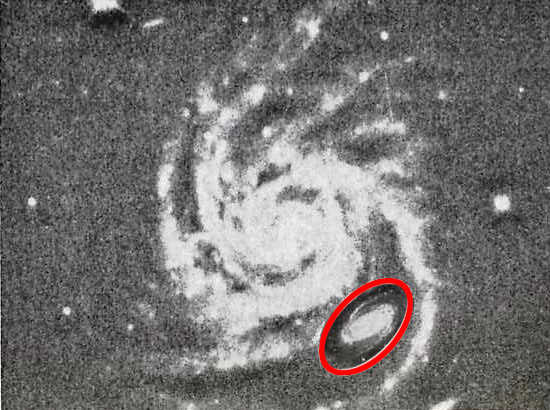
home •
about •
essential guide •
picture of the day •
thunderblogs •
news •
multimedia •
predictions •
products •
get involved •
contact

Credit: Halton Arp, Seeing Red
pic of the day
archive
subject index
abstract
archive
Links:
Society for
Interdisciplinary
Studies
Feb 14, 2005
Big Bang Distortions
Halton Arp's intrinsic redshift observations contradict the big bang's assumption that redshift is a measure of distance (and thus of age; the higher the redshift, the farther away from us and the closer to the beginning of the universe). Can this contradiction be tested? Three clues should be obvious: if redshift is distorting distance, then size, energy and distribution will all be systematically out of proportion as well.
We covered one instance of energy distortion in the Aug 20, 2004 TPOD, "How Big is a Gamma Ray Burst?" Arp showed that high and low redshift objects are clustered together in family groupings, so the errors introduced to the distance calculations should be proportionally larger as the redshift becomes higher. So the distortions should be greatest at the highest redshifts. In other words, when reading mainstream astronomy, you would expect to come across comments like: "gamma ray bursts in the early universe were much stronger than more recent gamma ray bursts."
One observation of a nearby faint gamma ray burst doesn't guarantee a distortion. It might actually BE a fainter burst. But there is more. The distribution of galaxies is also distorted by mistaking redshift for distance. This results in an odd-looking universe where streams of galaxies appear to point at the Earth from every direction. We covered this type of distortion in the Oct 18th TPOD "Fingers of God".
The third type of distortion that should appear by believing that galaxies and galaxy groups are farther away than they actually are is a distortion of size. The above image juxtaposes two galaxies at the sizes they would be if they are at their conventional redshift distances. The low-redshift M81 (inset) is one of the largest nearby spiral galaxies. The higher-redshift NGC 309 (large image), an otherwise normal-appearing spiral, has been distorted so much by assuming that it's at its redshift distance that it appears to swallow M81 in one of its arms.
Like Ptolemy's epicycles, these distortions disappear when we refocus our vision to accept the way these galaxies are distributed as the more accurate measure of distance, and reject the "first guess" hypothesis that redshift equals distance that has dominated astronomy for 80 years.
EXECUTIVE EDITORS:
David Talbott, Wallace Thornhill
MANAGING EDITOR: Amy Acheson
CONTRIBUTING EDITORS: Mel Acheson, Michael Armstrong, Dwardu Cardona,
Ev Cochrane, C.J. Ransom, Don Scott, Rens van der Sluijs, Ian Tresman
WEBMASTER: Michael Armstrong
Copyright 2005: thunderbolts.info